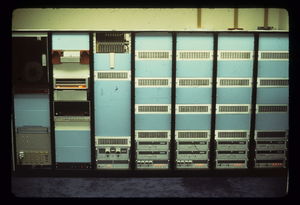Difference between revisions of "Maxc"
(Expand somewhat) |
|||
| Line 1: | Line 1: | ||
| − | + | [[Image:Maxc.jpg|300px|right|thumb|Xerox Maxc]] | |
| − | [[ | + | '''Maxc1''' and '''Maxc2''' (often capitalized '''MAXC''') were a pair of [[PDP-10]] clones made at [[Xerox PARC]], after the Xerox corporate level objected to the acquisition of machines from outside the company, instead of from Xerox's subsidiary, Xerox Data Systems - [[Scientific Data Systems]] before it was acquired by Xerox. (They chose the PDP-10 as they wanted to be able to run [[INTERLISP]].) |
| − | + | They were [[microcode]]d machines, using an 72-bit [[instruction|microinstruction]]. They contained 2K [[word]]s of microcode, and microinstructions executed in 200 nsec (Maxc1); 4K words, at 150 nsec (Maxc2). The hardware supported up to 16 levels of [[subroutine]] calls in the microcode. This capability was used to support bulk data transfers (from [[disk]] [[mass storage]]); a technique which was later used in the [[Xerox Alto|Alto]]. | |
| − | == | + | A [[front end]] (a [[Data General Nova]] on Maxc1, and an Alto on Maxc2) was used to load and [[debug]] the microcode; all the [[input/output]] [[peripheral]]s other than the disks were also connected to the front end. |
| + | |||
| + | The [[main memory]] was built out of then-novel [[Dynamic RAM|DRAM]] [[integrated circuit|chips]] from [[Intel]], the new [[Intel 1103]] 1Kx1 chip. It used [[error-correcting code|ECC]] to produce reliable memory; with a [[word]] length of 48 bits (compared to the PDP-10's native length of 36 bits; only 7 of the extra 12 bits were used for the ECC), it could correct all single-bit errors, and detect (but not correct) double-bit errors. Thus, single failed chips could be ignored, and replaced during scheduled maintenance. | ||
| + | |||
| + | They ran the [[TENEX]] [[operating system]]; to do this, Maxc implemented [[virtual memory]] mechanisms comparable to those added to the [[KA10]] by [[Bolt, Beranek, and Newman|BBN]], including a 102x18 bit mapping memory. | ||
| + | |||
| + | Maxcl built during the period from February 1971 to April 1973; it was de-commissioned early in 1981. Maxc2 was built between June 1975 and April 1977. | ||
| + | |||
| + | {{semi-stub}} | ||
| + | |||
| + | ==Further reading== | ||
| + | |||
| + | * Michael A. Hiltzik, ''Dealers of Lightning: Xerox PARC and the Dawn of the Computer Age'', HarperBusiness, New York, 1999 - pp. 99-116 | ||
| + | |||
| + | ==External links== | ||
* [https://github.com/PDP-10/maxc/blob/master/pdf/the_maxc_systems.pdf The Maxc Systems] - good, detailed paper by Edward R. Fiala of PARC, one of the builders | * [https://github.com/PDP-10/maxc/blob/master/pdf/the_maxc_systems.pdf The Maxc Systems] - good, detailed paper by Edward R. Fiala of PARC, one of the builders | ||
* [http://www.bitsavers.org/pdf/xerox/maxc/ MAXC] - MAXC documents at BitSavers | * [http://www.bitsavers.org/pdf/xerox/maxc/ MAXC] - MAXC documents at BitSavers | ||
| + | ** [http://www.bitsavers.org/pdf/xerox/maxc/Pictures/ Pictures] - images of the machine; internals, under construction, and finished | ||
** [http://www.bitsavers.org/pdf/xerox/maxc/MAXC_Operations_May74.pdf Maxc Operations] | ** [http://www.bitsavers.org/pdf/xerox/maxc/MAXC_Operations_May74.pdf Maxc Operations] | ||
| + | ** [http://www.bitsavers.org/pdf/xerox/maxc/MAXC_8.2_Spec.pdf The MAXC Microprocessor] | ||
[[Category: PDP-10s]] | [[Category: PDP-10s]] | ||
Revision as of 19:31, 25 October 2021
Maxc1 and Maxc2 (often capitalized MAXC) were a pair of PDP-10 clones made at Xerox PARC, after the Xerox corporate level objected to the acquisition of machines from outside the company, instead of from Xerox's subsidiary, Xerox Data Systems - Scientific Data Systems before it was acquired by Xerox. (They chose the PDP-10 as they wanted to be able to run INTERLISP.)
They were microcoded machines, using an 72-bit microinstruction. They contained 2K words of microcode, and microinstructions executed in 200 nsec (Maxc1); 4K words, at 150 nsec (Maxc2). The hardware supported up to 16 levels of subroutine calls in the microcode. This capability was used to support bulk data transfers (from disk mass storage); a technique which was later used in the Alto.
A front end (a Data General Nova on Maxc1, and an Alto on Maxc2) was used to load and debug the microcode; all the input/output peripherals other than the disks were also connected to the front end.
The main memory was built out of then-novel DRAM chips from Intel, the new Intel 1103 1Kx1 chip. It used ECC to produce reliable memory; with a word length of 48 bits (compared to the PDP-10's native length of 36 bits; only 7 of the extra 12 bits were used for the ECC), it could correct all single-bit errors, and detect (but not correct) double-bit errors. Thus, single failed chips could be ignored, and replaced during scheduled maintenance.
They ran the TENEX operating system; to do this, Maxc implemented virtual memory mechanisms comparable to those added to the KA10 by BBN, including a 102x18 bit mapping memory.
Maxcl built during the period from February 1971 to April 1973; it was de-commissioned early in 1981. Maxc2 was built between June 1975 and April 1977.
Further reading
- Michael A. Hiltzik, Dealers of Lightning: Xerox PARC and the Dawn of the Computer Age, HarperBusiness, New York, 1999 - pp. 99-116
External links
- The Maxc Systems - good, detailed paper by Edward R. Fiala of PARC, one of the builders
- MAXC - MAXC documents at BitSavers
- Pictures - images of the machine; internals, under construction, and finished
- Maxc Operations
- The MAXC Microprocessor
